


xxxxxBy the time the Europeans
arrived in North America, the Cherokee tribe was firmly settled in
the Carolinas, Tennessee and parts of Georgia and Alabama. The
Spanish explorer Hernando de Soto passed through their land in 1539,
and it was in Georgia in 1733 that the English philanthropist James
Oglethorpe made the first European settlement. The Cherokee
supported the Crown during the American War of Independence and, as
a result, lost much of their territory at the end of the conflict.
When gold was discovered in Georgia in 1827, demand grew for the
removal of the native Indians. In 1830 Congress passed the Indian
Removal Act by which native Indians could to be forcibly ejected
from their homelands. The final blow came in 1835 when some senior
Cherokees sold their land to the government. In 1838 U.S. forces arrived in Georgia and forced-
THE CHEROKEE AND THE TRAIL OF
TEARS 1838 -
Acknowledgements
Cherokee: Cherokee Indian
Sitemap, artist unknown. Map (USA):
licensed under Creative Commons – https://asd-
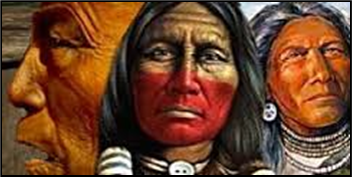 xxxxxThe Cherokee
Indians are thought to have originated in present day Texas and the
northern part of Mexico, and to have migrated to the area of the
Great Lakes in prehistoric times. Here they came in conflict with
the Delaware and Iroquois tribes and, getting the worst of it, moved
to the south east, settling in what is now the Carolinas, Tennessee,
and the northern regions of Georgia and Alabama. Within a
comparatively few years they had become the most powerful and
advanced tribe in that region. The Spanish explorer Hernando de Soto
passed through their territory in 1539 -
xxxxxThe Cherokee
Indians are thought to have originated in present day Texas and the
northern part of Mexico, and to have migrated to the area of the
Great Lakes in prehistoric times. Here they came in conflict with
the Delaware and Iroquois tribes and, getting the worst of it, moved
to the south east, settling in what is now the Carolinas, Tennessee,
and the northern regions of Georgia and Alabama. Within a
comparatively few years they had become the most powerful and
advanced tribe in that region. The Spanish explorer Hernando de Soto
passed through their territory in 1539 -
xxxxxIn the struggle between the
British and French for control of North America, the Cherokee had
tended to side with the British and, during the American War of
Independence they openly supported the forces of the Crown. This
proved their undoing. After the success of the American rebels, they
were obliged to agree to a series of humiliating treaties by which
they lost vast areas of their land in the Carolinas. Some of the
tribe, about 3,000, sensing trouble ahead, moved west of the
Mississippi, but the majority stayed on, developing their farming
and cattle ranching, and maintaining a well-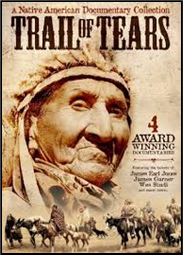 society.
In 1827 the tribe went so far as to establish the Cherokee Nation,
with a system of representative government based closely on the US
model. But by then its fate was virtually sealed. Valuable gold
deposits had been discovered in the mountains to the north, and as
early as 1819 Georgia had asked the U.S. government to expel the
Cherokee from the state. This appeal had failed, but in 1828 Georgia
took the law into its own hands and laid claim to the tribal lands.
This was judged as illegal by the U.S. Supreme Court, sitting in
1832, but by then President Andrew Jackson had signed the
society.
In 1827 the tribe went so far as to establish the Cherokee Nation,
with a system of representative government based closely on the US
model. But by then its fate was virtually sealed. Valuable gold
deposits had been discovered in the mountains to the north, and as
early as 1819 Georgia had asked the U.S. government to expel the
Cherokee from the state. This appeal had failed, but in 1828 Georgia
took the law into its own hands and laid claim to the tribal lands.
This was judged as illegal by the U.S. Supreme Court, sitting in
1832, but by then President Andrew Jackson had signed the
xxxxxThexfinal
blow came in 1835 when, by the Treaty of
New Echota, about 500 prominent Cherokee
were cajoled into selling their ancestral home for five million
dollars, and moving to the so-
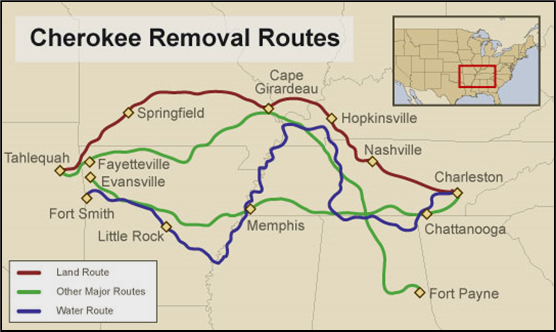 xxxxxIn the weeks that followed, only a few hundred Cherokee
and Creek Indians managed to escape and settle on land in the North
Carolina mountains -
xxxxxIn the weeks that followed, only a few hundred Cherokee
and Creek Indians managed to escape and settle on land in the North
Carolina mountains -
xxxxxNor did matters improve much after being “settled” in the Indian Territory. Here, having joined up with the Chickasaw, Choctaw, Creek and Seminole (becoming known as the Five Civilized Tribes), they come up against thousands of tribesmen from the north, many of whom had sadly and reluctantly accepted their removal to less productive land. Feuds broke out across the region as each tribe attempted to establish its own territory. Then, with the coming of the American Civil War in 1861, the Five Tribes supported the South and came out the losers. After the conflict, tribal ownership of land was abolished, and in the late 1880s the government of the Cherokee Nation was dissolved, its people becoming U.S. citizens when Oklahoma was made a state in 1907. From then on white settlers began to pour into the region.
 xxxxxIncidentally, it was during
the Trail of Tears (or, literally, “The Trail where they cried”)
that the legend of the Cherokee Rose was born. It is said that,
after the chiefs had prayed for a sign to bring comfort to all the
mothers and to give them the strength to care for their children, a
beautiful white rose sprang up wherever a mother’s tear touched the
ground. The white was seen as the colour of the tear; the bright
gold centre as the gold which had been stolen from their land; and
the seven petals as representing the seven Cherokee clans. We are
told that this rose -
xxxxxIncidentally, it was during
the Trail of Tears (or, literally, “The Trail where they cried”)
that the legend of the Cherokee Rose was born. It is said that,
after the chiefs had prayed for a sign to bring comfort to all the
mothers and to give them the strength to care for their children, a
beautiful white rose sprang up wherever a mother’s tear touched the
ground. The white was seen as the colour of the tear; the bright
gold centre as the gold which had been stolen from their land; and
the seven petals as representing the seven Cherokee clans. We are
told that this rose -
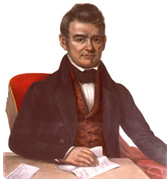
xxxxxThe man who served the
Cherokee Indians well during their troubled times was their tribal
leader John Ross
(1790-
xxxxxOver the next ten years he struggled relentlessly to keep his tribe in their ancestral lands, using every means short of war. He sent petitions to President Andrew Jackson, and in the early 1830s went to Washington to plead his case in person. His efforts were of no avail. When eviction eventually came in 1838, he led his people in the “trail of tears”, sharing in their ordeal and overseeing their resettlement in the Indian Territory. And it was there that he helped write a constitution for the United Cherokee Nation, and was chosen as chief when the new government was formed.
Including:
John Ross,The Second and
Third Seminole Wars, and
George Catlin

xxxxxAnother tribe which
resisted eviction was the Seminole in Florida. As we have seen, they
had already battled with government forces in 1817 to keep hold of
their homeland. In the Second Seminole War,
beginning in 1835, they again put up a good fight, but with the
capture of their able leader Osceola in 1837 they were forced to
surrender in 1842. And some resistance was shown among tribes north
of the Ohio River. In 1832, for example, the Sauk leader Black Hawk
took on the government in the so-
xxxxxOn his return home in 1838
he assembled his paintings -
xxxxxParamount among Catlin’s
writings was his Manners, Customs and Conditions
of the North American Indian, a two-
xxxxxA tribe which was even more determined than the Cherokee to hold on to their native lands were the Seminole in Florida. As we have seen, they had already fought one war with the American government in 1817, when federal forces had attempted to drive them out of the peninsula, then owned by the Spanish. This struggle was resumed in 1835 when the American government, on the strength of the Indian Removal Act of 1830, attempted once again to evict them and, this time, to drive them to those designated native areas in the far West.
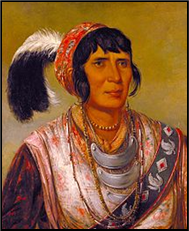 xxxxxBut,xlike the first encounter,
the Second Seminole War
showed the Seminoles to be a resourceful enemy. Led by their capable
leader Osceola
(1804-
xxxxxBut,xlike the first encounter,
the Second Seminole War
showed the Seminoles to be a resourceful enemy. Led by their capable
leader Osceola
(1804-
xxxxxInxthe Third Seminole War, waged from 1855 to 1858, the Indians again used their
bases in the Everglades to launch persistent raids upon white
settlements. Eventually, however, more U.S. troops were drafted into
the area, and they were forced to give up their struggle. Over 200
were re-
xxxxxIncidentally, there were also earlier instances of armed resistance against relocation amid the tribes north of the Ohio River. In 1832, for example, after the Sauk had been evicted from their homeland, their chief, Black Hawk, led his people back to their lands in Illinois, together with a contingent from the nearby Fox tribe. There they began planting crops again, but not for long. Federal troops were summoned, together with local militia forces, and in the Black Hawk War that followed the Indians stood little chance. They were defeated near the Wisconsin River in the July, and in the Bad Axe Massacre of the following month, and Black Hawk was forced to surrender. ……
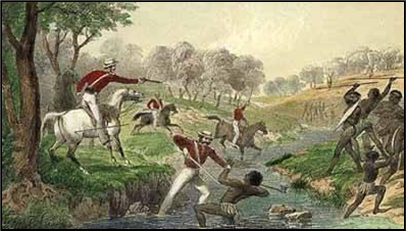 xxxxx…… Andxitxwas at this time that a similar attack upon an
indigenous population was carried out on the island of Tasmania. In
1828, after years of conflict between the native Aboriginals and the
British colonists -
xxxxx…… Andxitxwas at this time that a similar attack upon an
indigenous population was carried out on the island of Tasmania. In
1828, after years of conflict between the native Aboriginals and the
British colonists -
xxxxxA man who recorded on
canvas and in writing the unique way of life of the American Indian
and “rescued it from oblivion” -
Va-



